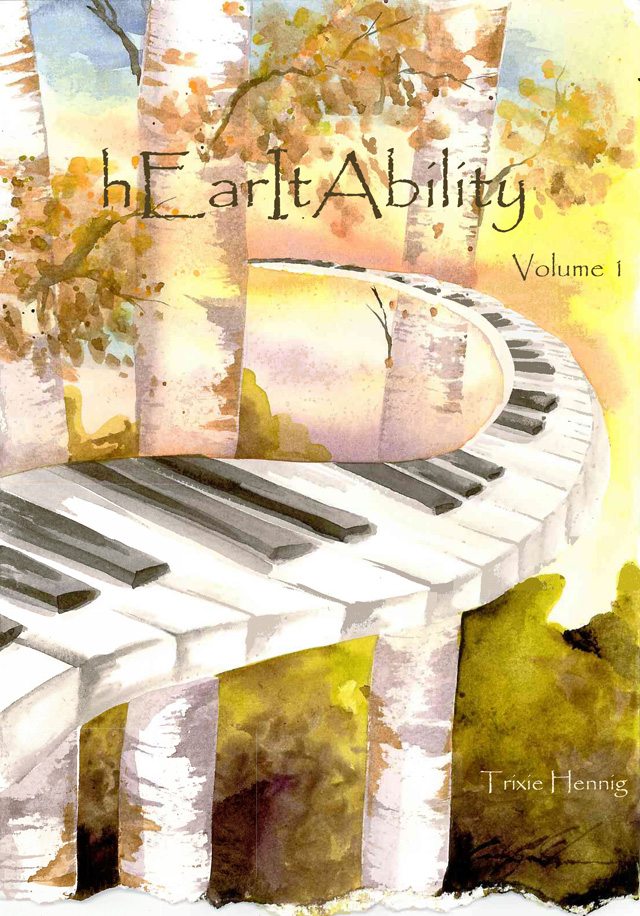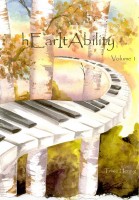Trixie Deckert Hennig is the author of the hEarItAbility series of books which teach musicians to play by ear using an innovative “Eyes and Ears” approach. We invited her to tell us a bit about this new approach and share some tips on ear training and learning to play music by ear.
First of all, could you tell us a bit about yourself, and your musical background?
 I started studying piano at the age of seven, eventually obtaining an Associate degree with Conservatory Canada (then, the Western Board of Music) studying with Maria Thompson, Eva Thompson, Diane Ferguson and Alexandra Munn, a Bachelor of Arts Honours degree from the University of Alberta studying with Marek Jablonski and Haley Simons and an Education degree from Concordia University College (Edmonton).
I started studying piano at the age of seven, eventually obtaining an Associate degree with Conservatory Canada (then, the Western Board of Music) studying with Maria Thompson, Eva Thompson, Diane Ferguson and Alexandra Munn, a Bachelor of Arts Honours degree from the University of Alberta studying with Marek Jablonski and Haley Simons and an Education degree from Concordia University College (Edmonton).
I enjoyed many successful festival performances, accompanying choirs, playing as an orchestral pianist for musicals and playing for church. I began teaching at the age of 14 and have enjoyed exposing many students (young and old!) to the world of music and piano. I have taught in the classroom and as school music specialist from Kindergarten to Grade 12. My goal is to have fun while working toward quality performances!
Currently, I teach private and group lessons, help organize a local piano festival and play for various local activities (church services, weddings, funerals), as I raise our three young children (ages 6, 4 and 1).
So tell us: why is learning music by ear important to musicians today?
Part of the joy of learning to play an instrument is the act of playing! To sit down and just enjoy time with your instrument, separate from practice, is part of the reward for learning.
Those who do not develop the skills to play by ear are left relying on printed music and the process of memorizing someone else’s ideas. One who develops the ability to play by ear is free to “noodle around”, find their way on the keys, reproduce that which is familiar, memorize much more efficiently (when desired) and generally, be able to play for anyone, anywhere, anytime!
Those who do not develop the skills to play by ear are left relying on printed music and the process of memorizing someone else’s ideas.
One who develops the ability to play by ear is free
Today’s musicians need to adapt to an eclectic range of musical styles and be able to create for survival! Many students love to play what is familiar to them and what better avenue than by ear! For musicians to succeed in today’s musical diversity, one must be prepared to play everything from Bach to Beethoven to country to folk to pop and everything in between, including composing and improvising.
Musicians who have well developed ears are in a far better position to succeed and enjoy music! Their musical instincts are heightened and their confidence to try things out and take risks is definitely increased.
There are four phrases I like to use to describe “hEarItAbility”:
- Play It – Write It
- Explore It – Explain It
- Hear It – See It
- Sound it out!
Traditional piano instruction focuses a good amount of time on the visual aspect of music (with the exception of jazz piano). Most students are given printed materials to learn from and play, with most of the work focused on reproducing what is seen – and getting it right. However, music is a language of sound.
With “hEarItAbility”, student encounters at the keyboard are focused on the sounds produced and organizing them into something recognizable through a “trial and error” model. All concepts are explored at the the keyboard and put into the context of music and only then identified, labelled and notated.
The hEarItAbility books unfold in two parts: Ears and Eyes.
In the Ears section, lyrics are provided for each song in addition to a visual presentation of the initial pitch and keys used. Students then use this as the springboard for figuring out the given song, discerning melodic contours as they go (up, down, same – close, far – step, leap). After mastering the melodies, students are encouraged to add bass notes, simple intervals and chords.
In the Eyes section, students are encouraged to write what they have discovered using letter names for keyboard recognition, traditional pitch notation, rhythm and chord symbols. Extension activities are provided to further enhance the musical experience.
As a student, I did not have a good ear. I struggled to notate what I heard, couldn’t hear intervals accurately, never attempted to even play “Happy Birthday” by ear and never was able to play when asked, unless I had my book!
In my early 20s, as contemporary music grew in my church and my cousins had little kids that I wanted to play nursery tunes for, I realized that I desired to “play by ear”. I thought “I’ve studied all these years. I really should be able to figure this out!”
And so began my self-guided adventure, after 13 years of traditional lessons. hEarItAbility has worked successfully with young beginners, advanced students who never thought they could play by ear, adults (beginners or experienced), ADHD students, Autistic students, extremely bright students, those with a natural ear, those without, even my neighbour who proclaims she can’t carry a tune and just fiddled around with it without any guidance!
I think the perception is that you either play by ear or you don’t, instead of realizing that it is a learned skill.
I really don’t know. We get so wrapped into what is expected and what we are accustomed to that we don’t pause for a really serious look at our methodology.
I think the perception is that you either play by ear or you don’t, instead of realizing that it is a learned skill. Sometimes, aural skills are treated suspiciously, as though they are a hinderance to learning to read notation. I desire for all the skills and knowledge musicians need to be integrated without giving one aspect priority over another.
Just sit down and “sound it out”! Pick a tune and go for it! Sing along and get those keys to match what you are singing.
On my self-guided journey, I struggled with knowing which key to start on and let’s face it, there are 88 to pick from. I may have known the key of the song, but the tune doesn’t always start on the tonic. Hence, the development of hEarItAbility! The book tries to set people up for success by displaying the pitches used in the piece and which one is the first one. It is good to move around the keyboard, too. So right from the beginning, when you have a tune figured out, move it somewhere else! Then, you can start adding some accompanying notes and harmonies.
YouTube tutorials are great as you can get some hints of where to start! Use those tutorials as a starting point – don’t just copy them, really use your ear.
Once you are along in the process, chord charts are great as you are guided to the proper chords/harmonies. Improvising over a set chord pattern is also a great way to develop your ear. Many pop tunes have a predictable, regular chord pattern, so go with that and create your own tune, focusing in on patterns and notes you like the sound of. Learning to experiment is a wonderful tool to learning, even learning the tough stuff someone else has written!
Sit down and play – even if it is “Twinkle Twinkle”, “Wavin’ Flag”, “Amazing Grace” or “Whistle While You Work”.
Whatever you can sing, sit down and figure out how to play it!
You can learn more about the hEarItAbility approach and buy Volume 1 of the book series at hEarItAbility.com.









